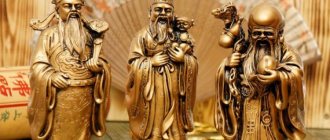Oh, shining with the light of millions of suns, God Ganesha! You have a huge body and the curved trunk of an elephant. Please always remove obstacles from all my righteous deeds!
Puranas
Ganesha (Sanskrit: गणेश) is the god of wisdom and prosperity, also called Ganapati. He is the son of the god Shiva and his wife Parvati.
The illusory material world of forms, limited in time and space, is under the protection of Ganesha. There is one interesting legend that tells how Ganesha became the patron of the ganas (host of demigods) and received this name, otherwise - Ganapati. Initially he was called Lambodar (i.e. with a big belly). He was victorious through his wisdom in the competition with his brother Kartikeya for the right to be the protector and guardian of all the ganas. They were given the task of going around the entire Universe as quickly as possible, and the one who does it first will win. Ganesha walked around his parents, personifying the Universal Universe (Shiva and Shakti), explaining that this world of forms is a manifestation of the highest energies of the Divine Father and Mother, who are the source of everything in the Universe. Meanwhile, Karttikeya was in a hurry to overcome the endless distances of outer space, which are the relative illusory world of manifested existence. There is no point in looking for truth far outside when it is always nearby. This lesson is also taught by Ganesha to us, to us, spiritual seekers who have embarked on the Path of spiritual self-improvement. There is no need to look for truth outside; it is stored in the soul of each of us, who are manifestations of the divine essence in the material world. So, we can find answers to all our questions only by looking inward, into the depths of our consciousness; it is there that the treasury of spiritual knowledge lies.
It is believed that Ganesha controls the Muladhara chakra, as he has power over the attachments and desires of the material world.
In the Puranas one can find different versions of his birth, and they all differ depending on the time of the story, according to the differences in the kalpas, for example, the Varaha Purana describes his birth thanks to Shiva, the Shiva Purana - from Parvati. According to the Shiva Purana, Genesha had two consorts: Siddhi - perfection, and Buddhi - intelligence, as well as two sons: Kshema or Subha - prosperity, and Labha - profit.
According to the Skanda Purana, Ganesha should be worshiped on the fourth lunar day of the month Bhadrapada (August 23 - September 22), it is believed that on this day Vishnu himself manifests in Ganesha and accepts gifts and worship.
O Ganesha, you were born on the first prahara on the fourth day of the dark fortnight of the month of Bhadra at the auspicious hour of moonrise. Since your form has emerged from the blessed mind of Parvati, your excellent vrata will be performed on or from this day. This will be conducive to the acquisition of all perfections (siddhi)
"Shiva Purana", ch. XVIII, 35–37
What kind of deity is this
Deity Ganesh, otherwise called Ganapati, is easy to remember due to his extraordinary appearance. It has the body of a man and the head of an elephant. Ganesha is considered the patron saint of those people who lead a righteous life, do not forget to pray and have bright thoughts. He directs all his kindness and favor to such people.
In his homeland, Ganapati, the god of prosperity and wisdom is one of the spirits that is especially revered by Indians. They show their respect by adding the prefix Sri to the name of the deity. Dancing Ganesha is the son of the supreme god Shiva and his wife, the daughter of the king of the mountains, Parvati. Ganesha's consorts are two goddesses: Buddhi, who rules the mind, and Siddhi, who controls success.
Ganapati's trunk is endowed with extraordinary power, with the help of which the deity can remove any obstacles, clearing the way for those who want to reach the top in any matter.
History of the character
The peaceful elephant-man belongs to the lower pantheon of gods of ancient India. Moreover, Ganesha is often referred to as a manifestation of Shiva (his father) rather than a separate being. The first images of God date back to the 5th century AD.
Initially, the deity did not exude the usual good nature at all. The first mentions of Ganesha are accompanied by the epithet “Creator of Obstacles.” Legend has it that Shiva gave the demigod the important duty of putting a spoke in people's wheels. Later the image was transformed into the “destroyer of all obstacles.” Now Ganesh has another task - to clear the path of obstacles for those who ask for it.
The image of a celestial being developed and acquired more and more responsibilities. Modern Ganesha represents the god of wealth and wisdom, an assistant in any endeavor, and the patron of art and writing.
View this post on Instagram
A post shared by Vedic Astrologer, numerologist (@astrologbelaya) on Feb 15, 2022 at 7:57am PST
It is generally accepted that the deity came into Vedic culture thanks to the ancient Dravidians (residents of South India and Pakistan). Gradually, the cult of the deity spread throughout India, partially integrating into Buddhism. There Ganesha is an emanation of Avalokiteshvara, that is, he embodies the infinite compassion of all Buddhas.
In the 6th century, the worship of Ganesha became a separate tradition called “Ganapatya”. Religion gained its greatest influence in the 10th century. It was at this time that famous temples dedicated to the elephant god were erected in India.
True, with all the love of Hindus for the gluttonous Ganesha, the religious tradition has not received noticeable spread. To this day, demigod worship is an addition to the core beliefs of Hindus.
Iconography of Ganesha
There are different images of Ganesha. Sometimes he is drawn with a yellow body, and in some cases with a red body. The deity has a large belly, 4 arms and a powerful elephant head with one tusk.
The god's belt is entwined with a snake, symbolizing energy, which can take many different forms.
In most paintings, Ganesha is seated on a lotus flower. Next to him you can always see a mouse or a rat (sometimes it is replaced by a shrew or a dog). Legend claims that a good god pacified this creature, which previously had the soul of the devil. The animal, which is a symbol of vanity and insolence, became so obedient that it allowed itself to be saddled. Since then Ganesha has been riding it. And Indians believe that Shri Ganesha helps spiritual growth by getting rid of fussiness, selfishness and pride.
We have selected interesting articles for you:
How do representatives of the elements Fire and Water get along?
11.12.2021
I Ching - Book of Changes
27.01.2019
Ganapati has several arms. In different images, their number can reach 4, 6, 8, 18 or 32. At the same time, he holds a lotus and a trident in his upper limbs. The fourth hand is positioned in such a way that it appears as if it is giving something to the person looking at the god. Sometimes it contains lada, a sweet treat made from rice flour. In other hands of the deity there may be the following objects:
- lasso, which helps to catch luck;
- an ax that cuts off all visible and invisible obstacles lying on the way to the goal;
- the shell, which is the source of wisdom;
- a staff, which is a symbol of the support a person needs throughout his life;
- a cup of abundance that brings prosperity and good energy to the home;
- a flatbread through which a person will be granted prosperity;
- lotus flower, symbolizing the development of the spirit.
The deity's trunk holds candy. It is a symbol of happiness, which gives liberation from the influence of negative energies. Ganesha needs large elephant ears in order not to miss a single request for help that people send to him in their prayers.
Meaning
Ganesha is the god of luck. Among his names, the most famous are: Ganapati, Vigneshvara, Vinayake, Pillayar, Binayak, etc.
The word “Ganesha” itself includes two separate words: “gana” (group, unity of many) and “isha” (god, teacher). The name "Ganapathi" can also be broken down into "gana" (some community) and "pati" (ruler).
The demigods (gana-devatas) were called Ganas; they were Shiva’s assistants and were headed by Ganesha. All demigods can be grouped into 9 classes: Adityas, Vishvadevs, Vasus, Tusitas, Abhasvaras, Anilas, Maharajikas, Sadhyas, Rudras.
The very first mention of the name "Ganapathi" is found in the Veda of Hymns (2.23.1).
The Sanskrit lexical dictionary of terms "Amarakosha" (authored by the sage Amara Sinha) calls Ganesha by the following names : Vignesha, or Vignaraja, Vinayaka and Vigneshvara (getting rid of obstacles), Dvaimatura (born of two mothers), Ganadhipa, Ekadanta (having one tusk), Heramba , Lambodara and Mahodara (with a full belly), Gajanana (elephant-faced), Dhavalikar (quickly included in the pantheon of gods).
The name Vinayaka is also mentioned in the names of eight Hindu temples in Ashtavinayak (Maharashtra state). Pilgrims from all over the world often gather in these sacred places to visit the temples in a specific order. All eight structures in honor of Ganesha are located around the city of Pune. Each of them has its own legend and history. The form and manifestation of the deity in the temples also differs from each other.
The Yatra (pilgrimage) is recommended to be carried out in the following order:
- Mayureshwar in Morgaon;
- Siddhivinayak in Siddhateka;
- Ballaleshwar in Pali;
- Varadavinayak in Mahad;
- Chintamani in Theura;
- Girijatamaj in Lenyadri;
- Vighnahar in Ozar;
- Mahaganapati in Ranjangaon.
Hidden meaning of Ganesha's body parts
Every part of the body of the immortal Ganapati has a meaning. The elephant's head represents the deity's prudence, constancy and devotion. The ears confirm the kindness of the spirit, symbolizing its endless nobility and desire to help those who need it.
The tusk symbolizes the focus on struggle, the desire to overcome the duality of human nature, to defeat its negative side, characterized by laziness, quarrelsomeness, anger and other destructive qualities.
A long trunk speaks of the high intellectual abilities of the deity. Ganesha was given a big belly as a sign of his generosity and generosity.
The Ganesha talisman will protect and help a person who wants to gain confidence and happiness.
Indian god of wisdom
Shri Ganesha - akasha-abhimani-devata - is a deity who is able to control the secondary ether (bhuta-akasha), produced under the influence of the guna of tamas. It combines the five primary elements of creation, and it also becomes the cause of the birth of false egoistic manifestations. He is significantly influenced by the god Shiva. Hearing is most closely related to the secondary ether. With the help of the ears one can perceive sound vibrations existing in the ether.
It should be recalled that Vedic knowledge was initially passed down from generation to generation orally. Ganesha is also known as the patron of knowledge (buddhi). In legends he is credited with high mental and intellectual abilities. One of the names of the deity is translated as “lover of knowledge” (Buddipriya), where “priya” means “lover” and “buddhi” means “knowledge”. If Ganesha blesses, then a person will be able to move to a new stage of spiritual development.
There is a well-known legend that the deity wrote down the text of the Mahabharata under the dictation of Vyasa, each verse of which has not only a direct meaning, but also ten hidden meanings. Secret knowledge is available only to those who can comprehend Vedic truth.
Hypotheses for the birth of God
In India, there are several legends that explain Ganapati’s unusual appearance.
According to the first of them, the mother of the future deity had long dreamed of a son, for which she passionately prayed to Vishnu. He honored her with mercy, and soon a boy was born to Shiva and Parvati. The happy parents decided to celebrate this event with a celebration to which everyone was invited. Among the guests was the god Shani, who had the ability to incinerate any object with his eyes. The gaze of this spirit fell on the baby, and instantly Ganesha’s head burned.
Shiva ordered the servant to bring the head of the first creature that came across him on the road. It turned out to be an elephant. Thus, Ganapati acquired the head of this animal.
According to the second version, the child lost his head due to the temper of his father, who tore it off with his own hands, thereby incurring the wrath of his wife. Wanting to quickly correct what he had done, Shiva attached the head of the first animal he came across - an elephant.
There is another legend according to which Parvati herself molded a child from clay and saffron and installed him near the entrance to her chambers as a guard. When Shiva arrived, the boy blocked his path, for which he was deprived of his head. However, the grief of his wife confused God, and he decided to make amends using his power. He brought the child back to life by giving him the head of an elephant.
According to legend, the Indian god Ganesha loves most of all balls made from corn and having a sweet core. Once, at his birthday party, he ate a large number of these balls, and then, while riding around on a mouse, he fell. This happened because the mouse got scared when it saw a snake crawling past, and threw off its rider. From the blow, all the sweets spilled out, but the god was not taken aback and immediately ate them again, and to be sure, he pulled his stomach with a snake, which became the reason for his fall.
About the elephant's head
The unusual appearance of the deity is also explained by several similar legends.
Although there is a legend that Ganesha was born with the head of an elephant, this version is not very popular.
It is generally believed that Ganesha was born as a beautiful boy with a human face, but was beheaded as a result of a terrible mistake or oversight.
The most common legend is that Shiva himself beheaded Ganesha, not yet knowing that he was his son.
According to this legend, Parvati ordered the newly created Ganesha not to let anyone near her while she was bathing. And when Shiva tried to enter the chamber, Ganeshi did not let him in and, in addition, defeated all his father’s guards. The angry Shiva himself took out a weapon and beheaded the brave warrior.
Another legend is also quite popular, according to which the god Shani, who was under a curse, was to blame for the appearance of Ganesha - he incinerated everything that his gaze fell on. It is believed that Parvati knew about this curse, but believed that it did not apply to Ganesha, and insisted that Shani look at the baby at the festival dedicated to his birthday.
Both legends have a similar continuation: upset Shiva and Parvati pray for the revival of Ganesha, but since the boy’s head cannot be found or restored, he is given the head of the first animal that came across the servant sent on the search. Some legends specify that the animal was supposed to sleep with its head to the north.
The servant comes across a baby elephant, it is his head that is brought to Shiva and it is this head that becomes the face of Ganesha. But don’t worry - according to legend, on the instructions of the gods, the baby elephant was dipped into the sea and his head appeared again, after which he came to life. And for his priceless gift from Ganesha, the baby elephant was blessed by the gods.
Appeal to Ganesha in the form of mantras
In order for the Indian deity Shri Ganesha to be heard by those living on earth, it is necessary to read a mantra dedicated to this god. At the same time, a special treatment is used for each purpose. You should read rhythmic combinations only in a good mood. It's better to sing them. This must be done at least 180 times, while feeling each spoken sound and conveying to it the purity and nobility of your thoughts.
For guard
To protect yourself from ill-wishers and enemies, you should recite the following mantra: “Mangalam dishtu me maheshwari.” This letter combination will lead a person to harmony with himself and the world around him, and will make him feel the sweetness of the release of negative energy.
For prosperity
If a person begins some difficult task or finds himself in a difficult situation from which he cannot find a way out, he should recite the following mantra: “Jay Ganesha Jay Ganesha Jay Ganesha pakhi mam Ganesha Ganesha Ganesha raksha mam gam Ganapataye namo namah om Ganeshaya namah” .
The energy of sounds will help cleanse the subtle energy layers and enlist the support of the god Ganapati. This combination should be pronounced by entrepreneurs, because... This mantra in business helps to eliminate obstacles of any nature.
To harmonize yourself
To get rid of fear, which often becomes an obstacle to achieving goals, you should read the following mantra: “Om gam ganapataye namah.” This letter combination will help you find harmony, find the right path that will bring success to a person.
The mantra “Om Sri Ganeshaye Namah” is recommended to be read by those people who are engaged in creativity or business. This short phrase will help to reveal a person’s potential, develop his talents, and make him feel freedom from doubts and uncertainty.
The following mantra will clear the mind of doubts, remove psychological barriers and fears: “Om Lakshmi-Ganapataye Namah.”
To fulfill your wishes
The mantra “Aum Ganadhipataye om Ganakridaye Namaha” is used when a person wants to achieve the fulfillment of any desire. However, this combination is also used more widely: it gives good luck, helps to achieve heights in professional activity, and start a business that will bring material well-being.
Ganesha in the teachings of Feng Shui
Many people are confused by the unusual appearance of the Indian god Ganapati, and they do not want to place his image at home. However, only a subtle mind will be able to discern behind the oddities of appearance a soul that is full of kindness and sincere generosity. Only the person who abandons stereotypes in thinking can gain spiritual freedom, self-confidence and harmony.
God Ganapati can be an effective amulet for many things. A figurine of a deity with the head of an elephant is installed at home or in the office. It can be worn on the hand or neck. The image of the spirit is placed in the wallet to attract material wealth.
It is a common idea that the larger the Ganesha figurine, the higher the likelihood of achieving success. However, there is no confirmation of this fact in Chinese teaching.
If, for unknown reasons, some part of the figurine suddenly broke off, for example, a hand or a tusk, or the base itself cracked, then this is a sure sign that the deity saved the owner of the house from some great danger. There is no need to get rid of such a talisman. You should try to attach the broken part to its original place, accompanying the process with words of sincere gratitude. Then the deity will restore its state and will be able to continue to protect the person who seeks his protection.
It is better to place a bronze statue of Ganesh in the west or north-west sector. A good place for it would be the right side of the desktop. A wooden figurine will strengthen family relationships, so the best place for it would be the southeastern or eastern sector.
It is not enough just to place the Indian deity in the right direction. Ganesha needs constant attention: you need to talk to him, rub your stomach and palms. Chanting mantras addressed to the elephant-headed god will help increase the intensity of energy flows in any sector. His favor can be won with the help of sweets, which should be placed on a saucer in front of the figurine.
Safety precautions for using the talisman
And here are the safety precautions for using this wonderful talisman of success - Ganesha: 1) Do not install a figurine or figurine of Ganesha in your home if it is chipped or cracked, otherwise this talisman will act in the opposite way, i.e. attract troubles. 2) Periodically clean the Ganesha figurine from dust and dirt so that nothing prevents this wonderful talisman from attracting success to you in all your affairs. 3) When stroking the Ganesha figurine on the trunk and asking yourself for success, do not use words with the particle “not”, and naturally, never wish failure on other people (even if they are your competitors). 4) When you wish for something, at the end of the phrase, be sure to say: “For my good and the good of everyone around me!” This will lead you to even greater success in business without harming anyone.








